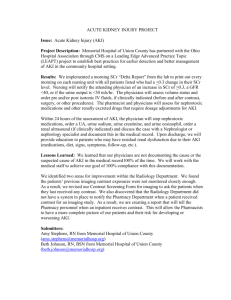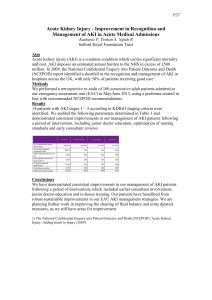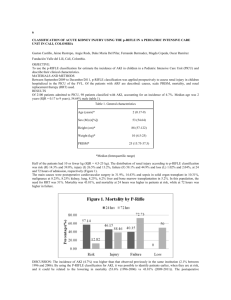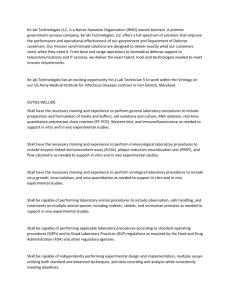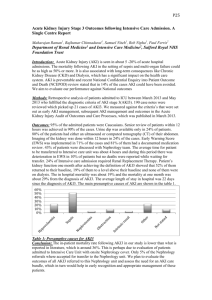ACUTE KIDNEY INJURY: EPIDEMIOLOGY, RISK FACTORS AND SURVIVAL ANALYSIS ABSTRACT BACKGROUND:
advertisement
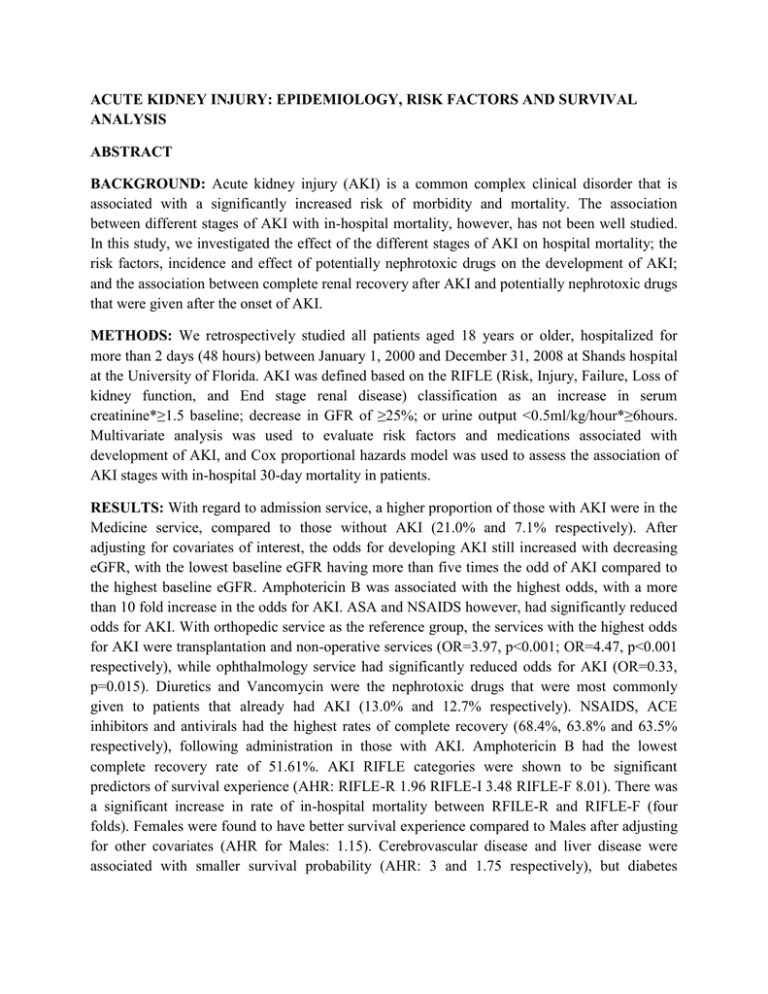
ACUTE KIDNEY INJURY: EPIDEMIOLOGY, RISK FACTORS AND SURVIVAL ANALYSIS ABSTRACT BACKGROUND: Acute kidney injury (AKI) is a common complex clinical disorder that is associated with a significantly increased risk of morbidity and mortality. The association between different stages of AKI with in-hospital mortality, however, has not been well studied. In this study, we investigated the effect of the different stages of AKI on hospital mortality; the risk factors, incidence and effect of potentially nephrotoxic drugs on the development of AKI; and the association between complete renal recovery after AKI and potentially nephrotoxic drugs that were given after the onset of AKI. METHODS: We retrospectively studied all patients aged 18 years or older, hospitalized for more than 2 days (48 hours) between January 1, 2000 and December 31, 2008 at Shands hospital at the University of Florida. AKI was defined based on the RIFLE (Risk, Injury, Failure, Loss of kidney function, and End stage renal disease) classification as an increase in serum creatinine*≥1.5 baseline; decrease in GFR of ≥25%; or urine output <0.5ml/kg/hour*≥6hours. Multivariate analysis was used to evaluate risk factors and medications associated with development of AKI, and Cox proportional hazards model was used to assess the association of AKI stages with in-hospital 30-day mortality in patients. RESULTS: With regard to admission service, a higher proportion of those with AKI were in the Medicine service, compared to those without AKI (21.0% and 7.1% respectively). After adjusting for covariates of interest, the odds for developing AKI still increased with decreasing eGFR, with the lowest baseline eGFR having more than five times the odd of AKI compared to the highest baseline eGFR. Amphotericin B was associated with the highest odds, with a more than 10 fold increase in the odds for AKI. ASA and NSAIDS however, had significantly reduced odds for AKI. With orthopedic service as the reference group, the services with the highest odds for AKI were transplantation and non-operative services (OR=3.97, p<0.001; OR=4.47, p<0.001 respectively), while ophthalmology service had significantly reduced odds for AKI (OR=0.33, p=0.015). Diuretics and Vancomycin were the nephrotoxic drugs that were most commonly given to patients that already had AKI (13.0% and 12.7% respectively). NSAIDS, ACE inhibitors and antivirals had the highest rates of complete recovery (68.4%, 63.8% and 63.5% respectively), following administration in those with AKI. Amphotericin B had the lowest complete recovery rate of 51.61%. AKI RIFLE categories were shown to be significant predictors of survival experience (AHR: RIFLE-R 1.96 RIFLE-I 3.48 RIFLE-F 8.01). There was a significant increase in rate of in-hospital mortality between RFILE-R and RIFLE-F (four folds). Females were found to have better survival experience compared to Males after adjusting for other covariates (AHR for Males: 1.15). Cerebrovascular disease and liver disease were associated with smaller survival probability (AHR: 3 and 1.75 respectively), but diabetes mellitus (DM) was associated with better survival experience after adjusting for other covariates (AHR:0.65). CONCLUSION: Nephrotoxic drugs have significant impact on development of AKI and outcome following AKI, and the rates of AKI varied depending on both patient and hospital service factors. While some of these could be explained, more research is needed to understand these differences, and provide suggestions on how to prevent or limit some of these risk factors, and possibly improve patient outcomes. Finally, this study shows that the severity of AKI by RIFLE classification is inversely associated with survival experience.
